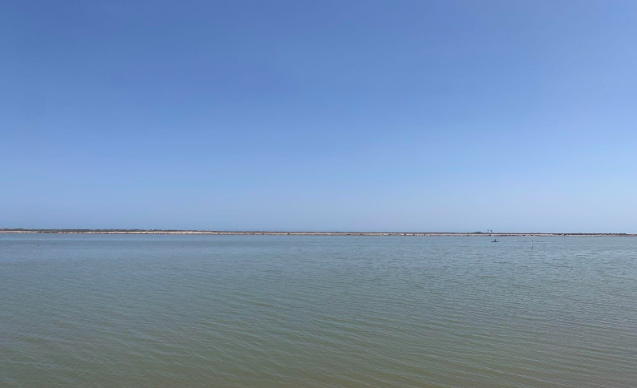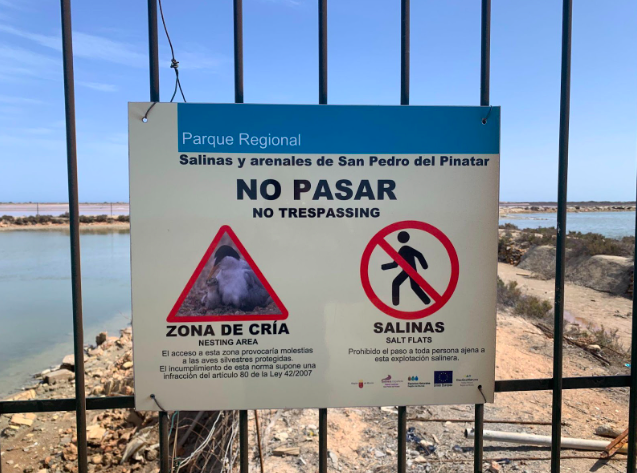Rights of Nature: the case of Mar Menor (Spain)
Ramón del Buey Cañas, UAM
2024
Mar Menor is the largest saline Mediterranean lagoon in Europe, with a surface area of 135 square kilometers and a maximum depth of 7 meters. It is located in the region of Murcia (Spain) and has a high ecological importance due to the habitats and species it hosts, some of them in danger of extinction. As a wetland for aquatic birds, it has an environmental value recognized by the different legal protection figures (since 1994, Mar Menor was included in the list of wetlands registered in the Ramsar Convention). However, in recent years Mar Menor has experienced a drastic deterioration, triggering a reaction that constitutes the first case of rights of nature in Europe: Law 19/2022, of September 30, for the recognition of legal personality to Mar Menor (hereinafter, Mar Menor Law).

Mar Menor, España. Ph. Ramón del Buey Cañas
The history of this ecosystemic collapse must go back at least to 1979, after the hydraulic project of the Tajo-Segura water transfer, when the waters of the first river reached those of the second. Campo de Cartagena, the enormous hydraulic slope of Mar Menor, began to be irrigated and agricultural uses changed completely: from rainfed agriculture to intensive irrigation, and Campo de Cartagena (previously a semi-desert area) became the “orchard of Europe”. In addition, since the last century Mar Menor has also been experiencing the pressure of metal mining and the impact of urban activity and its tourist infrastructures (housing developments, artificial beaches and marinas). All these factors began to alter the lagoon, but its basic functioning did not change substantially until 2016. From this year onwards, the ecosystem was unable to absorb more nutrients, especially those coming from the brines after the desalination of groundwater (300.000 tons of nitrates stored in the Cuaternario aquifer, under Campo de Cartagena, mainly as a consequence of intensive irrigation, with more than 8.500 hectares that have been recognized as illegal). This surplus of nutrients became available to plankton, and since the warmer than normal winter of 2015, a series of eutrophication processes or massive explosions of phytoplankton have been occurring. The water became turbid and light stopped reaching the bottom of the lagoon. This turbidity lasted for months, the communities of photosynthetic organisms at the bottom of the lagoon were unable to survive without light and died. The affected waters began to experience strong changes in oxygen levels. On October 12, 2019, after an episode of torrential rains, tons of fish and crustaceans appeared dead due to anoxia (lack of oxygen). On August 23, 2021 a new anoxia caused 4.5 tons of dead fish.
The legislation prior to the Mar Menor Law has been ineffective. One of the keys to this failure is that the different applicable legal regimes generated concurrent competences of the various Administrations (state, autonomous and local) that posed a challenge of coordination against which the different governing organs have not been up to the task. Secondly, certain conducts of the public authorities and competent Administrations have contributed to impede or deactivate the legal protection of Mar Menor: repeal of previous regulations and even rejection of protection plan concessions financed by the European Union. Thirdly, political corruption: there has been a lack of a system of inspection and surveillance of illegal agriculture and livestock activities in Mar Menor. This ineffectiveness of preventive action is evident in the intervention of the courts and tribunals, the most relevant example of which is the criminal prosecution of certain crimes of pollution and environmental prevarication (the so-called Topillo Case, initiated in 2017).

Mar Menor, España. Ph. Ramón del Buey Cañas
All of the above constitutes the context from which the Mar Menor Law arises, the result of a Popular Legislative Initiative (PLI): a citizen mobilization of 700,000 people that fed back into a study on the possibility of endowing Mar Menor with legal personality and its own rights. This study was coordinated by Professor Teresa Vicente, began in the 2019/2020 academic year at the Legal Clinic of the Faculty of Law of the University of Murcia and concluded in May 2020 with a publication in the press. The very broad citizen mobilization made it possible for the theoretical proposal of this legal study to be considered by the legislative organs. After passing the corresponding formalities, on April 5 2022 took place in the Plenary of the Congress of Deputies the taking into consideration of the PLI, being approved. From there it passed to the Senate, where the amendments were discussed, and from there it was voted again and approved as Law 2022/19 of September 30, being published in the Official Gazette of the State on October 3, 2022.
Article 1 of the Mar Menor Law grants legal personality to Mar Menor. Article 2 recognizes its right to: (i) exist and evolve by a natural order or ecological law that makes it possible for it to exist as a lagoon and terrestrial ecosystem; (ii) be protected, limiting, stopping and not authorizing those activities that pose a risk or damage to the ecosystem; iii) be conserved, requiring actions for the preservation of terrestrial and marine species and habitats and the management of associated protected natural areas; iv) be restored, requiring, once damage has occurred, repair actions that reestablish natural dynamics and resilience, as well as the associated ecosystem services. Article 3 specifies the representation and governance of the Mar Menor in three figures: a Committee of Representatives, composed of members of the Public Administrations; a Monitoring Commission; and a Scientific Committee, of which an independent commission of scientists and experts, universities and research centers will form part.
In the face of the contemporary ecosocial crisis, the adoption of an ecocentric perspective by the legal system is a vitally important factor. In this sense, the case of Mar Menor deserves special attention. In addition to extending to Europe the legal revolution initiated in Latin America at the beginning of the 21st century with the recognition of the rights of nature, it is a hopeful example of how citizen mobilization can contribute to this “ecology of law”.
Further readings and resources
Salazar Ortuño, E. & Vicente Giménez, T. «La iniciativa legislativa popular para el reconocimiento de personalidad jurídica y derechos propios al Mar Menor y su cuenca». Revista Catalana de Dret Ambiental, 2022, Vol. 13, Núm. 1, pp. 1-38.
Vicente Giménez, T. Justicia ecológica y derechos de la naturaleza. Valencia, Tirant Humanidades, 2023.
Ley 19/2022, de 30 de septiembre, para el reconocimiento de personalidad jurídica a la laguna del Mar Menor y su cuenca: https://www.boe.es/eli/es/l/2022/09/30/19— https://ilpmarmenor.org/
